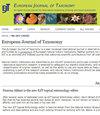Linear listing order and hierarchical classification: history, conflict, and use
IF 1.3
3区 生物学
Q3 ENTOMOLOGY
引用次数: 0
Abstract
Taxonomic criteria alone are not sufficient to determine a linear sequence for the arrangement of collection specimens according to a preferred classification or the linear sequence according to which taxa are best discussed in articles or books. The choice of methodology to obtain a linear sequence of taxa in agreement with a hierarchical classification has been little studied and remains controversial. In this article, I offer an historical background, before examining properties, use and limits of possible listing criteria. The result of a linearization effort depends on arbitrary choices with respect to two aspects of the hierarchical classification we intend to linearize. One is the order to be followed in listing the immediately subordinate members of a given taxon, the other is the choice of the sets of taxa to be linearized according to tradition, alphabetic order or other criterion. The example presented here, related to the “orders” of Hexapoda, demonstrates the need to specify very clearly the extent and composition of the uncollapsed classification backbone retained in the linearization procedure.线性列表顺序和分级分类:历史、冲突和使用
仅凭分类标准还不足以确定按照首选分类法排列采集标本的线性序列,也不足以确定文章或书籍中最适合讨论哪些分类群的线性序列。对于如何选择方法来获得分类群的线性序列,以符合分级分类法,研究很少,而且仍存在争议。在本文中,我首先介绍了历史背景,然后探讨了可能的列表标准的特性、用途和局限性。线性化工作的结果取决于我们打算线性化的等级分类的两个方面的任意选择。其一是在列出给定分类群的下级成员时所遵循的顺序,其二是根据传统、字母顺序或其他标准选择要线性化的分类群集合。这里介绍的与六足纲 "目 "有关的例子表明,有必要非常明确地说明线性化过程中保留的未折叠分类骨架的范围和组成。
本文章由计算机程序翻译,如有差异,请以英文原文为准。
求助全文
约1分钟内获得全文
求助全文
来源期刊

European journal of taxonomy
ZOOLOGY-
CiteScore
2.30
自引率
8.30%
发文量
173
审稿时长
29 weeks
期刊介绍:
EJT is a fully refereed, international, fully electronic Open Access journal in descriptive taxonomy, covering subjects in zoology, entomology, botany (in its broadest sense), and palaeontology. EJT-papers must be original and adhere to high scientific (content) and technical (language, artwork, etc.) standards. Manuscripts that are clearly substandard in either of these categories will not be sent out for review. EJT is supported by a consortium of European Natural History Institutes, but its scope is global. Both authorship and geographical region of study need not be European. Authors are, however, strongly encouraged to involve European Natural History collections by consulting material or by depositing specimens (e.g. types and figured material) related to their published paper in the collection of a European Natural History Institute.
 求助内容:
求助内容: 应助结果提醒方式:
应助结果提醒方式:


